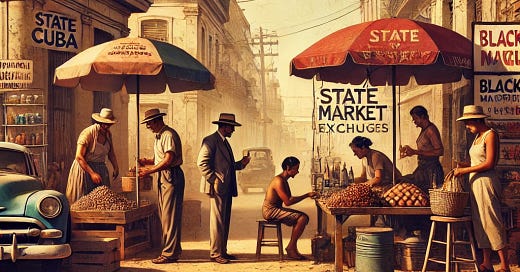2025: Cuba's Economic Crossroads
Regressive Policies, Market Reforms, and the Shadow of Inefficiency
It has been almost two weeks since the announcement of Cuba’s economic policies for 2025. Initially, I didn’t plan to write about them, as it often feels redundant to highlight how these policies are destined to fail. Yet, I feel compelled to address the latest developments—not only to share these updates but also to analyze them through the lens of economics.
As with every year, the Communist Party of Cuba convened its plenaries, which typically serve to outline updates to economic planning and policy. Over the summer, I discussed how the regime’s price controls and tightened import regulations hinted at a rollback of prior reform efforts. Now, with recent legislative changes—most notably, the prohibition of private wholesale markets—it is evident that this regressive trend is accelerating.
In a recent interview with ADN Cuba, I shared my perspective on Resolution 56, stating:
"[The decree] further reduces the competitiveness of the Cuban market through the effective monopolization of wholesale supply and the decrease in competition between private and state entities."
I elaborated further:
“Cuba has transformed into a country dominated by economic agents focused on rent-seeking. Instead of prioritizing efficient and productive ways to satisfy consumer needs, they rely on legislative protections and privileges for survival. This applies primarily to state-owned enterprises but also to the GAESA conglomerate and certain private monopolies closely aligned with the Party.”
Unfortunately, these concerns barely scratch the surface. During the plenary, Minister of Economy and Planning Joaquín Alonso Vázquez announced an expected economic growth of 1% for 2025. This projection seems wildly unrealistic given the dire economic circumstances. Over the past four years, economic growth has been consistently negative, even when taking the regime's dubious statistics at face value. Worse still, CEPAL (the Economic Commission for Latin America and the Caribbean) projects continued economic contraction in 2023, 2024, and 2025. Even by the regime’s own estimates, Cuba has only met its economic growth targets twice in the past 13 years.
Adding to the bleak outlook, the Cuban government announced the implementation of a floating exchange rate for the first time since the 1990s. The presumed goal is to capture the informal currency trading, which has become essential for SMEs importing goods to the island. However, with the announcement of the Resolution 56, SMEs are importing less to the island and as such the informal exchange rate has been declining over the past month. Yet it is difficult to assess whether the floating exchange rate will have any impact in consumer goods given that wholesale markets are no longer private.
It remains unclear whether the new exchange rate system will be genuinely free-floating or dirty. What is clear, however, is that the main beneficiaries of these economic updates are state enterprises and their directors. With new price controls and relaxed import rules for intermediate goods, state enterprises continue to solidify their dominance as the principal economic agents in Cuba. A testimony published in 14yMedio highlights the systemic obstacles Cuban entrepreneurs face:
“The government continues to impose obstacles on Cuban entrepreneurs, such as barring direct imports to ensure state import companies face no competition, or capping prices on essential food items like chicken and oil to discourage private sales—while state stores sell these items at double the price.”
The regime’s recent announcement estimating the number of “economically vulnerable” individuals also warrants scrutiny. According to their figures, approximately 320,000 people—or about 3.18% of the population—lack sufficient income to cover basic services and food, have no relatives obligated to provide support, and live in households without employed members. However, these numbers are far from credible. A recent survey indicates that nearly 90% of Cubans live in extreme poverty, while a USDA study estimates that 37.8% of the population suffers from food insecurity. The government’s figures are, quite frankly, detached from reality.
In closing, these new market reforms evoke David Levy’s paper, The Bias in Centrally Planned Prices, where he argued that, in the Soviet Union, store managers and clerks had no incentive to set prices at market-clearing levels. Instead, they preferred prices below market-clearing levels, creating shortages they could exploit through black market sales. While I am not suggesting this is the exact mechanism state enterprise directors and their managers will use, we can reasonably expect a stronger presence of these actors in the black market. Now that state enterprises control wholesale markets, opportunism will undoubtedly thrive.




